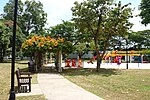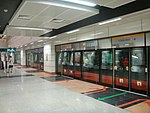Fort Tanjong Katong

Fort Tanjong Katong, which stood from 1879 to 1901, was one of the oldest military forts built by the former British colonial government of Singapore. The fort gave its name to today's Fort Road, and it used to stand on the grounds of the present Katong Park. Fort Tanjong Katong, the only one of its kind on the eastern side of the island, was part of a series of defensive batteries and fortifications along the southern coast of Singapore, that defended the eastern approaches to the Singapore Harbour and Singapore Town against seaborne attacks. Due to its poor structural design and remoteness, the fort was subsequently abandoned and buried until its rediscovery in 2001. Found with traces of a moat and near intact perimeter wall, the fort was considered by local archaeological experts as one of Singapore's most important archaeological finds of a "true 19-century fort" to date. As a result, an archaeology group has been lobbying for the site to be gazetted as a National Monument. As of May 2010, the National Heritage Board has stated that it has no plans to gazette the fort for the time being.
Excerpt from the Wikipedia article Fort Tanjong Katong (License: CC BY-SA 3.0, Authors, Images).Fort Tanjong Katong
Katong Park,
Geographical coordinates (GPS) Address Nearby Places Show on map
Geographical coordinates (GPS)
| Latitude | Longitude |
|---|---|
| N 1.2966666666667 ° | E 103.88666666667 ° |
Address
Former Fort Tanjong Katong
Katong Park
431014 , Marine Parade
Singapore
Open on Google Maps






